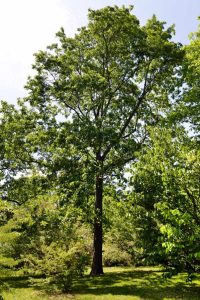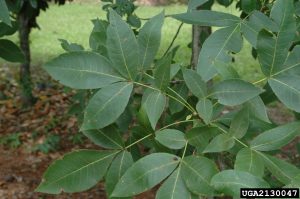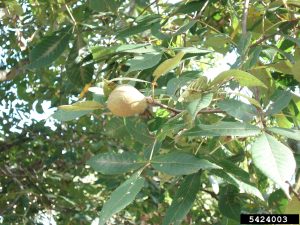Pignut Hickory, Carya glabra

Photo by Danny Schissler

Photo by Chris Evans, University of Illinois, Bugwood.org

Photo by Franklin Bonner, USFS (ret.), Bugwood.org
Height: 50 to 100 feet
Spread: 30 to 100 feet
LANDSCAPE USE
Serves well as a long-lived specimen or shade tree. Very good tree for upland restoration. Excellent where showy fall color is desired.
FORM
A large, straight-trunked tree with a broad, spreading crown of stout limbs.
NATIVE RANGE
Upland dry to mesic hammocks. Massachusetts southward to central peninsular Flonda, and west to Iowa, eastern Kansas, and eastern Texas.
CHARACTERISTICS
Flowers: Tiny, borne in relatively inconspicuous, drooping catkins.
Leaves: Compound, usually with 5 or 7 leaflets, dark green above, paler below. Turning golden to burnt orange in autumn.
Fruit: A nut borne in a large, globose, 1-2 inch-long husk that splits along several seams at maturity. September and October.
Bark: Grayish; shallowly fissured with diamond-patterned ridges.
CULTURE
Soil: Does best in fertile, well-drained, slightly acid soil.
Exposure: Part sun to shade.
Water: Supplemental irrigation not required once established.
Hardiness Zones: 4 to 9.
Life Span: Slow growing and long-lived. Matures at about 200 years, and specimens to 400 years are known.
BEST FEATURES including WILDLIFE SUPPORT
Long-lived. Provides shade for humans and food for wildlife, including nut-eating mammals, many moth species which are critical migrating bird food. Web worms do not harm the tree and feed birds. One of the faster growing hickories. Exceptionally beautiful fall color in October and November.
COMPANION PLANTS
Oaks (Quercus spp.), Black Walnut (Juglans nigra), Basswood (Tilia americana), Sourwood (Oxydendrum arboreum), Beech (Fagus grandifolia), Florida Sugar Maple (Acer saccharum subsp. floridanum), Sweetgum (Liquidambar styraciflua), Spruce Pine (Pinus glabra), Winged and American Wlms (Ulmus alata and U. americana), Sweetshrub (Calycanthus floridus), Beautyberry (Callicarpa americana), American Hophornbeam (Ostrya virginiana), Red Buckeye (Aesculus pavia).
DISADVANTAGES
Hickories are deciduous and drop both their large, coarse leaves and their large, hard fruits during the fall, the latter of which can do damage to mowers and may require removal. Should not be used in parking areas as the large fruit can cause damage to vehicles.
ALLERGENIC AND TOXIC PROPERTIES
Pollen may be an airborne allergen.
SIMILAR AND RELATED SPECIES
Several hickories occur in Florida. The Mockernut (C. alba) is a large upland tree that is similar in form to the Pignut but has very hairy leaves. The Sand Hickory (C. pallida) and Scrub Hickory (C. floridana), the latter of which is found only in Florida’s central scrub, are smaller than the others and do best in well-drained sandy soils. The Bitternut Hickory (C. cordiformis) occurs in Florida only sparingly in the floodplains of larger rivers in the northern reaches of the Florida Panhandle. It and the Shaggy-barked Water Hickory (C. aquatica), which is useful along retention ponds, prefer moist soils.